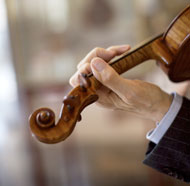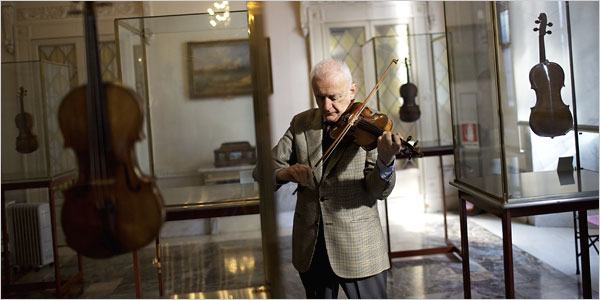CREMONA,
Italy — A violin, it turns out, needs to be played, just as a
car needs to be driven and a human body shooed off the couch. In
this city that produced the best violins ever made, that job belongs
to Andrea Mosconi. He is 75, and for the past 30 years, six days a
week, he has finger-fed 300-year-old violins, worth millions, a diet
of Bach, Tchaikovsky and Bartok.
Mr. Mosconi has been playing the museum’s
violins for 30 years.
 It
is peaceful where he works, in a chapel-turned-museum here, so it
jars when he compares his gentle job to the roar of Formula One
racing. He is nothing but serious about what he does.
It
is peaceful where he works, in a chapel-turned-museum here, so it
jars when he compares his gentle job to the roar of Formula One
racing. He is nothing but serious about what he does.
“It is not a matter of habit,” Mr. Mosconi said. “When Schumacher
gets to 350 kilometers an hour, do you think he ever loses his
concentration?” he added, speaking of the retired racing champion
Michael Schumacher.
“In my case, too, I have to pay attention,” he said. “You have to
give your best with these instruments. They make you sweat.”
 He
had just finished playing a few lines of Bach on the most valuable
piece in this town’s small but significant collection of locally
made stringed instruments: a violin made in 1715 by Antonio
Stradivari, whose name itself has come to signify the perfection
allowed to man.
He
had just finished playing a few lines of Bach on the most valuable
piece in this town’s small but significant collection of locally
made stringed instruments: a violin made in 1715 by Antonio
Stradivari, whose name itself has come to signify the perfection
allowed to man.
It was the kind of exercise, at once heroic and the slightest bit
melancholy, repeated endlessly around Italy: driven by zeal to keep
the nation’s superlative past alive, and dogged by worry that the
past may overshadow a less glorious future. That tension is on
display at the violin museum at the city hall in Cremona, where the
modern violin was born and built, to a standard not yet surpassed,
by the families of Amati, Guarneri and Stradivari.
Every morning, Mr. Mosconi, the city’s official musical
conservationist, stands before pristine, multilocked glass cases and
faces three violins by the Amatis (one of the first makers of the
modern violin, from the mid-16th century), two by the Guarneris and
four instruments — three violins and a cello — by Stradivari. Mr.
Mosconi has no favorite: The very question is a mild affront.
“It’s as if you were to ask me which of my three children I
preferred,” he said.
Why these violins sound so much better than others, and so are
preferred by the masters who can afford them, has never been fully
accounted for. Theories range from the possibility that their wood
was fermented in saltwater or somehow affected by the ice age to
their having been constructed with special glues, varnishes or metal
plates.
“It’s unexplainable, how it was able to rise to such heights,”
Mr. Mosconi said, dismissing the many who have tried to replicate
the so-called Cremona sound. “First it was the Americans, then the
Japanese, then the Russians. Then the Americans again.
“But no one has ever come close,” he said. “Let them try. But
then it is the musicians who make their choices. As scientists they
have to try everything because it is their job, even though there
are more important things to worry about.”
But this mystery of molecules and millimeters, edged one way or
another by each master violin maker, comes with another: that to
keep fit and sounding their best, violins need to be played.
“The wood gets tired,” explained Karl Roy, a German violin maker
and one of the rarefied field’s top experts. “It’s the same as with
a human being. If you just sit and rest in your comfortable chair,
when you get up after a while you will feel crazy.”
And so, Mr. Roy said in a telephone interview from Germany,
collections of instruments made by Stradivari and other top violins
around the world are all played regularly. That, Mr. Mosconi
suggested, is the special care he gives to Cremona’s collection,
played every morning but Sunday and when he is on vacation in
August. He does not play the cello, but he contracts a young
musician to work with the single one in the collection, built by
Stradivari in 1700.
“I think this is the only place in the world where they are
treated like we treat them,” he said.
Mr. Mosconi — who was born in Cremona, began playing the violin
at age 9, studied violin making and went on to teach and perform —
starts his work at 8 a.m., an hour before the museum opens. He
stores his tools in a tastefully concealed closet: two bows, resin,
baby-soft cotton rags and jugs of distilled water for the humidifier
that keeps the air at the perfect moisture to preserve the
instruments.
Getting down to work, he unlocks the cases and carefully removes
each instrument. He tunes them, then plays each for six or seven
minutes. He starts with scales and arpeggios, then something more
substantial, on a recent day one of Bach’s partitas for the violin.
Nothing less would do.
“A great instrument should get great music and also a great
performer,” he said. A multimillion-dollar violin in hand, he paused
for a moment to ponder his own place. “Not that I am a great
performer,” he said. “But I do my work.”
He does it in a jacket and tie, which seems appropriate. He is
more business and reverence than poetry when he talks about his
privileged job.
Most violinists never get near a Stradivarius and still, three
decades after he began, he feels the weight of caring so closely for
so many.
Asked if he liked his job, he said: “It’s a difficult question. I
don’t really know. I asked the same question to my son, who is a
surgeon. He said, ‘It’s hard, but I wanted to do it.’
“Everyone says I am lucky,” he added. “But every coin has two
faces.”
original story posted at
http://www.nytimes.com/2007/06/03/world/europe/03cremona.html

 It
is peaceful where he works, in a chapel-turned-museum here, so it
jars when he compares his gentle job to the roar of Formula One
racing. He is nothing but serious about what he does.
It
is peaceful where he works, in a chapel-turned-museum here, so it
jars when he compares his gentle job to the roar of Formula One
racing. He is nothing but serious about what he does.  He
had just finished playing a few lines of Bach on the most valuable
piece in this town’s small but significant collection of locally
made stringed instruments: a violin made in 1715 by Antonio
Stradivari, whose name itself has come to signify the perfection
allowed to man.
He
had just finished playing a few lines of Bach on the most valuable
piece in this town’s small but significant collection of locally
made stringed instruments: a violin made in 1715 by Antonio
Stradivari, whose name itself has come to signify the perfection
allowed to man.